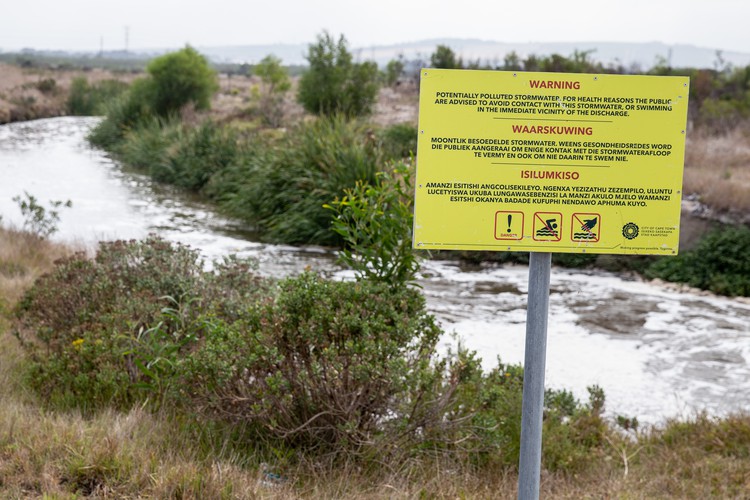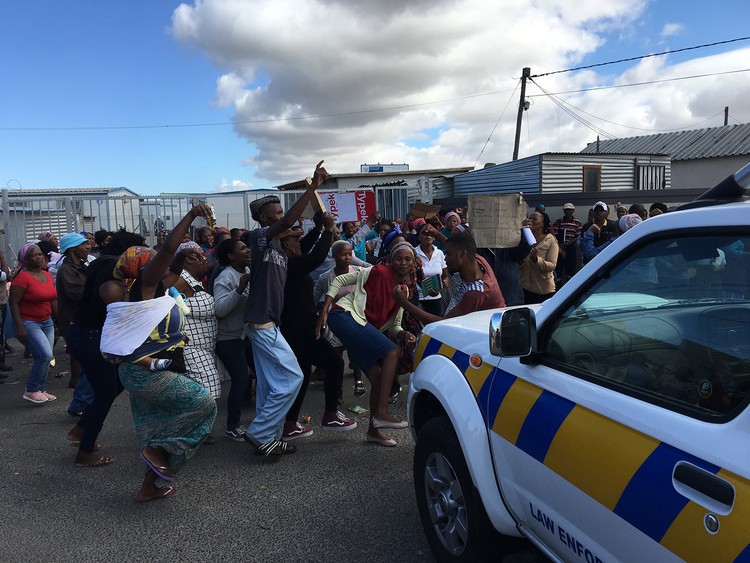A nearby community is convinced it is, but test results are inconclusive
Are residents of a Cape Town neighbourhood being poisoned by one of the city’s main waste treatment plants? A Carte Blanche exposé
in January said yes. Residents of Sandvlei were shown suffering with
sores and tummy infections. Scientists too have warned that the plant is
“in crisis, discharging sewage into the lower Kuils River and causing
horrific health effects for the people who live along the river.”
GroundUp investigated.
The Carte Blanche exposé accused the City of pumping “raw sewage” into the Kuils River upstream from Sandvlei. The accusation was made some weeks earlier by scientists in a Daily Maverick op-ed. This, Carte Blanche and the experts suggested, may be the cause of E. coli infections and other health problems, such as skin rashes in children, in the community.
GroundUp visited Sandvlei, a rural community in Macassar near Somerset West. We saw a steady stream of dark, murky waste water with floating clumps of foam flowing into the Kuils River upstream from the settlement. It was easy to access both the effluent stream and the Kuils River.
Horses grazed nearby and we heard accounts of children unwittingly playing in the mud and water. The City said it is not possible to fence off the river, but, it has put up a sign warning residents about the “potentially polluted” water.
Salie listed a bunch of health ailments she suspects may be caused by the polluted river: E. coli infections, skin rashes, boils, joint pains, migraines, pneumonia, diarrhoea and upset stomachs, tumours and an increased risk of cancer. SUCO dismisses suggestions that there is no scientific proof of the link between the treatment works and the community’s health.
Salie wants the river to be clean. “We want the Zandvliet plant to stop pumping sewage into it.”

Maryam Salie wants the river running through her neighbourhood to be cleaned.
But, a recent test complicates claims that effluent discharge by the
Zandvliet plant is the cause of the Kuils River’s pollution. CSIR
researcher Bettina Genthe, who conducted this test, was interviewed for
the Carte Blanche segment. In her interview, she confirmed that the
adjacent section of the Kuils River was contaminated with chemicals and
high levels of E. coli.But, Genthe said, her attempts to explain the complexity of making a definitive causal link between the treatment works’ effluent discharge, the poor water quality and the health problems in the community was not included in the Carte Blanche segment.
She tested samples taken on four occasions at different locations: from the Kuils River upstream of the treatment works, from the stream of effluent flowing from the treatment works, from the Kuils River at the Zandvlei community, and from further downstream.
The results show that the Kuils River, including the Sandvlei section of the river, is seriously polluted. The levels of nitrogen and phosphate, chemicals that feed the growth of algae and bacteria, in the effluent were high. But the results also show that the Zandvliet plant was not pumping untreated sewage into the river – at least not on the four occasions that the samples were taken – and that it was not the sole, nor perhaps even the primary contaminant of the Kuils River at the Sandvlei section. The results showed that the E. coli level (807.75 per 100 ml) was within the limit (1000 per 100 ml) set by the Department of Water and Environmental Affairs.
Dr Kevin Winter, a water quality expert at the University of Cape Town, looked at the CSIR results and agreed that the E. Coli level was “not alarming” and the treatment works were “doing a pretty good job” on the days that the samples were taken.
The results show that the poor quality of the river at Sandvlei were likely caused by a range of sources upstream from the treatment works. For example, the levels of E. coli in the water sample taken upstream were significantly higher than those in the effluent flowing from the treatment works.
“The results show us that the poor water quality of the river cannot be blamed on a single source. The effluent from Zandvliet is flowing into an already contaminated river,” Genthe said.
Other sources of contamination likely include industry, agriculture, informal settlements and suburban areas.

This is where the Kuils River (left) meets the outflow of the waste treatment plant (right).
But, the fact remains: the Kuils River flowing through the Sandvlei
community is polluted and the community is suffering from health
problems. Whether the health problems are caused by the river is
unclear.Proving causality, explains physician and infectious diseases specialist Dr Sean Wasserman, is complicated. First, you have to show there’s an outbreak of an infection; this means that the ailment is occurring more than expected.
Once an outbreak is confirmed, government investigators have to test a hypothesis about the cause of the infection. To do this, they must run what is called a case control study. This involves comparing an infected group with a similar group of uninfected people. By trying to find out what the infected group was more exposed to than the uninfected group, the investigators may be able to identify a cause of the infection.
Wasserman took issue with Carte Blanche quoting unqualified people who jumped to a conclusion about the cause of poor health outcomes in the Sandvlei community.
Carte Blanche executive producer Wynand Grobler told GroundUp that the program only reported the Sandvlei community’s claims that the pollution of the river was causing various infections. “At no point did we say that [cyanotoxins] is the cause [of the ailments] and that it is coming directly from the Zandvliet plant,” he said.
The CSIR results and the lack of proof do not exonerate the City or the Zandvliet plant. Xanthea Limberg, Mayoral Committee Member for Water and Waste Services, maintains that the “biological activated sludge processes” used at Zandvliet “are considered best practice for municipal wastewater treatment and the same treatment process is still implemented at new plants and plant upgrades the world over.”
But, experts, such as the ones who wrote the Daily Maverick article, believe the facility is overburdened. Put bluntly: it has too much shit to process.

Zandvliet is one of the city’s largest waste treatment plants.
Dr Jo Barnes, a retired University of Stellenbosch epidemiologist, told GroundUp that the “pong” of sewage from Zandvliet is proof enough that the plant is not functioning well.
She said that the E. coli count found by the CSIR is not always a reliable indicator. The plant’s chemical treatment may kill E. coli, but it is possible that other dangerous but difficult to test for pathogens in faeces remain.
Also, the results only show E. coli and chemical levels on the days that the samples were gathered. Large variations are possible. The scientists who wrote in the Daily Maverick said that in November Zandvliet “discharged millions of litres of what we observed to be raw, unfiltered sewage into the Kuils River” after storm water overwhelmed the plant.
Professor Leslie Petrik, one of the writers of that article, said that the regulations for effluent discharge are outdated. They do not deal with some contaminants found in pharmaceuticals, industrial chemicals and everyday household products. One of her recent studies for the Water Research Council showed that many of these compounds are found in marine life in False Bay. This shows a causal link between Zandvliet and chemical contamination in marine life.
“Water quality guidelines and effluent discharge limits need serious attention,” she said, adding that we can all do our part by shifting to biodegradable products in our homes.







